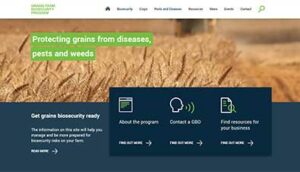Read the latest information on
Foot-and-mouth disease
Plant Health Australia (PHA) in partnership with Grain Producers Australia (GPA) have launched an online hub of industry-specific biosecurity resources and tools.
 Designed with grain growers in mind, the easy to use Grains Farm Biosecurity website provides fact sheets, videos, how-to guides, online training and strategies to prepare producers to manage on farm biosecurity risks.
Designed with grain growers in mind, the easy to use Grains Farm Biosecurity website provides fact sheets, videos, how-to guides, online training and strategies to prepare producers to manage on farm biosecurity risks.
Australia’s $18 billion grains industry generates more than 170,000 jobs and export grains to the value of $13.9 billion. With a high reliance on exports, maintaining market access through the implementation of good biosecurity practices is critically important to the grains industry.
“With zero market tolerance for live pests in grain, farm biosecurity should be top of mind. The new website offers a suite of practical biosecurity management tools that make a big difference,” says Stuart Kearns, PHA’s National Manager, Preparedness and RD&E.
The industry-specific website provides:
Delivered as part of the Grains Farm Biosecurity Program, established in 2007 and managed by PHA, the website aims to improve the management and preparedness for biosecurity risks in the grains industry at farm and industry levels.
Establishing good biosecurity practices on farm is not only good for individual businesses but it also adds another layer of protection to Australia’s world-class biosecurity system.
Everyone has a role to play in protecting Australia against harmful pests and diseases, so if you spot anything unusual or find something you are unsure about, call the Exotic Plant Pest Hotline on 1800 084 881.
Visit the Grains Farm Biosecurity website for the latest grains biosecurity news and information.